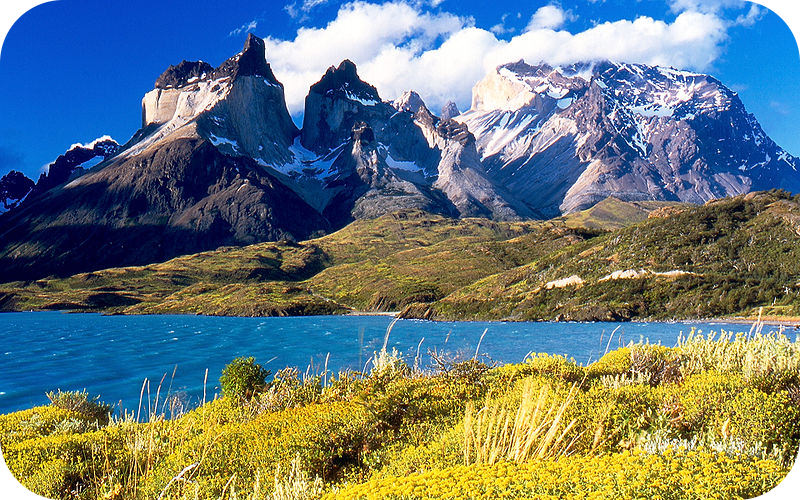READ: Types of Fossils
READ: Types of Fossils
Very few circumstances lead to fossils that are as beautiful and complete as this baby mammoth that was frozen in ice. An animal falling into a crevasse or a tar pit does not undergo the scattering and degradation that an animal dying at the surface does and so fossils from these types of rare sites are often fantastic.
Types of Fossilization
Most fossils are preserved by one of five processes outlined below:
Five types of fossils: (a) insect preserved in amber, (b) petrified wood (permineralization), (c) cast and mold of a clam shell, (d) pyritized ammonite, and (e) compression fossil of a fern.
Preserved Remains
Most uncommon is the preservation of soft-tissue original material. Insects have been preserved perfectly in amber, which is ancient tree sap. Mammoths and a Neanderthal hunter were frozen in glaciers, allowing scientists the rare opportunity to examine their skin, hair, and organs. Scientists collect DNA from these remains and compare the DNA sequences to those of modern counterparts.
Permineralization
Trilobite.
The most common method of fossilization is permineralization. After a bone, wood fragment, or shell is buried in sediment, mineral-rich water moves through the sediment. This water deposits minerals into empty spaces and produces a fossil. Fossil dinosaur bones, petrified wood, and many marine fossils were formed by permineralization.
Molds and Casts
When the original bone or shell dissolves and leaves behind an empty space in the shape of the material, the depression is called a mold. The space is later filled with other sediments to form a matching cast within the mold that is the shape of the original organism or part. Many mollusks (clams, snails, octopi, and squid) are found as molds and casts because their shells dissolve easily.
Replacement
The original shell or bone dissolves and is replaced by a different mineral. For example, calcite shells may be replaced by dolomite, quartz, or pyrite. If a fossil that has been replace by quartz is surrounded by a calcite matrix, mildly acidic water may dissolve the calcite and leave behind an exquisitely preserved quartz fossil.
Compression
Some fossils form when their remains are compressed by high pressure, leaving behind a dark imprint. Compression is most common for fossils of leaves and ferns, but can occur with other organisms.
Clues From Fossils
Seashells at 20,000 feet!
On his voyage on the Beagle, Charles Darwin noticed many things besides just the Galapagos finches that made him famous. Another important discovery was shell beds high in the Andes Mountains. How did they get there? He determined that they must mean that mountains rise slowly above the ocean, an idea that was being championed at the time by Charles Lyell. If this is the case, Darwin reasoned, the mountains and Earth must be extremely old.
Fossils are our best form of evidence about Earth history, including the history of life. Along with other geological evidence from rocks and structures, fossils even give us clues about past climates, the motions of plates, and other major geological events. Since the present is the key to the past, what we know about a type of organism that lives today can be applied to past environments.
History of Life on Earth
That life on Earth has changed over time is well illustrated by the fossil record. Fossils in relatively young rocks resemble animals and plants that are living today. In general, fossils in older rocks are less similar to modern organisms. We would know very little about the organisms that came before us if there were no fossils. Modern technology has allowed scientists to reconstruct images and learn about the biology of extinct animals like dinosaurs!
Environment of Deposition
By knowing something about the type of organism the fossil was, geologists can determine whether the region was terrestrial (on land) or marine (underwater) or even if the water was shallow or deep. The rock may give clues to whether the rate of sedimentation was slow or rapid. The amount of wear and fragmentation of a fossil allows scientists to learn about what happened to the region after the organism died; for example, whether it was exposed to wave action.
Geologic History
The presence of marine organisms in a rock indicates that the region where the rock was deposited was once marine. Sometimes fossils of marine organisms are found on tall mountains indicating that rocks that formed on the seabed were uplifted.
Climate
By knowing something about the climate a type of organism lives in now, geologists can use fossils to decipher the climate at the time the fossil was deposited. For example, coal beds form in tropical environments but ancient coal beds are found in Antarctica. Geologists know that at that time the climate on the Antarctic continent was much warmer. Recall from Concept Plate Tectonics that Wegener used the presence of coal beds in Antarctica as one of the lines of evidence for continental drift.
Index Fossils
An index fossil can be used to identify a specific period of time. Organisms that make good index fossils are distinctive, widespread, and lived briefly. Their presence in a rock layer can be used to identify rocks that were deposited at that period of time over a large area.
Summary
- Very few fossils preserve soft parts; some insects are preserved in amber and animals may be preserved in ice.
- Some fossils are created when minerals replace the organic material.
- A fossil may be in the form of a mold, which is the depression left in the shape of the material or a cast, which is rocky material that filled the mold.
- Fossils tell a lot about the environment during the time they were deposited.
- Climate is one important thing that can be indicated by fossils since organisms have specific conditions in which they can live.
- An index fossil must be distinctive, widespread and short-lived so that it can identify a specific period of time.
